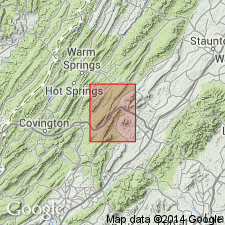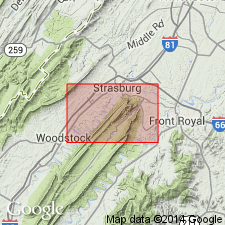
- Usage in publication:
-
- Lantz Mills facies
- Modifications:
-
- Named
- Dominant lithology:
-
- Limestone
- AAPG geologic province:
-
- Appalachian basin
Summary:
Named the Lantz Mills facies of the Edinburg formation for exposures along Swover Creek near Lantz Mills, Shenandoah Co., VA. Consists of cobbly to nodular buff-weathering limestone. Facies is mainly developed in northern and western parts of the Shenandoah Valley. The equivalent facies, the Liberty Hall, is a relatively thicker body of black limestone and shale. Thickness of the Lantz Mills facies where it is typically exposed is 188 feet. Unit is of Middle Ordovician age.
Source: GNU records (USGS DDS-6; Reston GNULEX).

- Usage in publication:
-
- Lantz Mills facies
- Modifications:
-
- Overview
- AAPG geologic province:
-
- Appalachian basin
Summary:
The Lantz Mills facies of the Edinburg Formation is a nodular, fine-grained, black limestone with little or no shale alternating with the Liberty Hall facies which is a fine-grained, dense, black, thin-bedded limestone separated by buff-weathering, fissile black shale.
Source: GNU records (USGS DDS-6; Reston GNULEX).

- Usage in publication:
-
- Lantz Mills Member
- Modifications:
-
- Revised
- AAPG geologic province:
-
- Appalachian basin
Summary:
Revised the Lantz Mills to a member of the Edinburg Formation. Unit is a dark-gray, nodular weathering, thin bedded limestone. The Lantz Mills Member interfingers with the Liberty Hall Member of the Edinburg Formation. The Lantz Mills Member is fossiliferous.
Source: GNU records (USGS DDS-6; Reston GNULEX).

- Usage in publication:
-
- Lantz Mills beds
- Modifications:
-
- Revised
- AAPG geologic province:
-
- Appalachian basin
Summary:
Revised the Lantz Mills to beds of the Edinburg Formation. The Lantz Mills beds are nodular-weathering, dark-gray to black, fine-grained, argillaceous limestone. It interfingers with the Liberty Hall beds of the Edinburg Formation. The Lantz Mills is the principal lithology in the eastern belt of the mapped area and is fossiliferous. Metabentonite beds are common.
Source: GNU records (USGS DDS-6; Reston GNULEX).
For more information, please contact Nancy Stamm, Geologic Names Committee Secretary.
Asterisk (*) indicates published by U.S. Geological Survey authors.
"No current usage" (†) implies that a name has been abandoned or has fallen into disuse. Former usage and, if known, replacement name given in parentheses ( ).
Slash (/) indicates name conflicts with nomenclatural guidelines (CSN, 1933; ACSN, 1961, 1970; NACSN, 1983, 2005, 2021). May be explained within brackets ([ ]).

